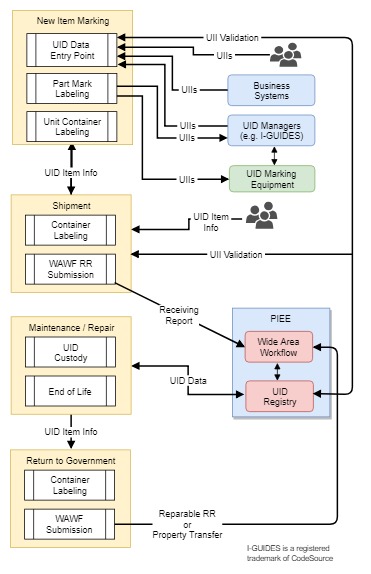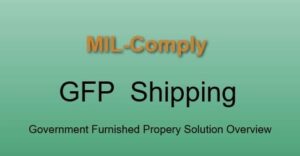The DOD’s Item Unique Identification (IUID/UID) initiative has revolutionized the military’s ability to keep track of what it owns. But it has also created substantial burdens on defense contractors that go far beyond just permanent part marking.
The challenges created by IUID data management fall into four phases of item lifecycle.
-
- Part Marking – requires that the contractor ensure that Unique Item Identifiers (UII) are valid and unique, while also collecting relevant data for label and shipment, including submission to the IUID Registry.
- Shipping – which includes Mil-Std-129 container marking and submission of IUID data on WAWF Receiving Reports can involve repetitive use of each UII numerous times. The shipping process becomes more complicated when Government Furnish Property (GFP) is involved, as explained below.
- Bonded Storage – is a factor for contractors that take responsibility for on-site warehousing of items it has sold to the Government. The contractor later ships those items on behalf of the Government as requested by it.
- GFP Maintenance and Repair – during which the contractor takes custody Government Furnished Property (GFP) while performing services on it. This requires a contractor to acknowledge custody to the IUID Registry of that it is servicing, then submit UIIs again on a WAWF Reparable Receiving Report (RRR) or Property Transfer (DD1149) when shipping. The need to sometimes add items to the UID Registry or handle end-of-life events (e.g. scrapping and warranty replacements) complicates the requirements. See our GFP Process Video for an overview of the process.
Because UID data is integral to all these processes it must be handled accurately and efficiently. This requires a highly integrated solution that is robust and comprehensive, whether it be provided by a single vendor or composed of point solutions from several.
MIL-Comply’s modular licensing approach allows it to be applied specifically to the areas of greatest need and work with your existing systems. It can scale up as needs grow and adapt to process changes. See the full IUID Life Cycle illustration (PDF) for more details.
More Information
- Part Marking – requires that the contractor ensure that Unique Item Identifiers (UII) are valid and unique, while also collecting relevant data for label and shipment, including submission to the IUID Registry.



